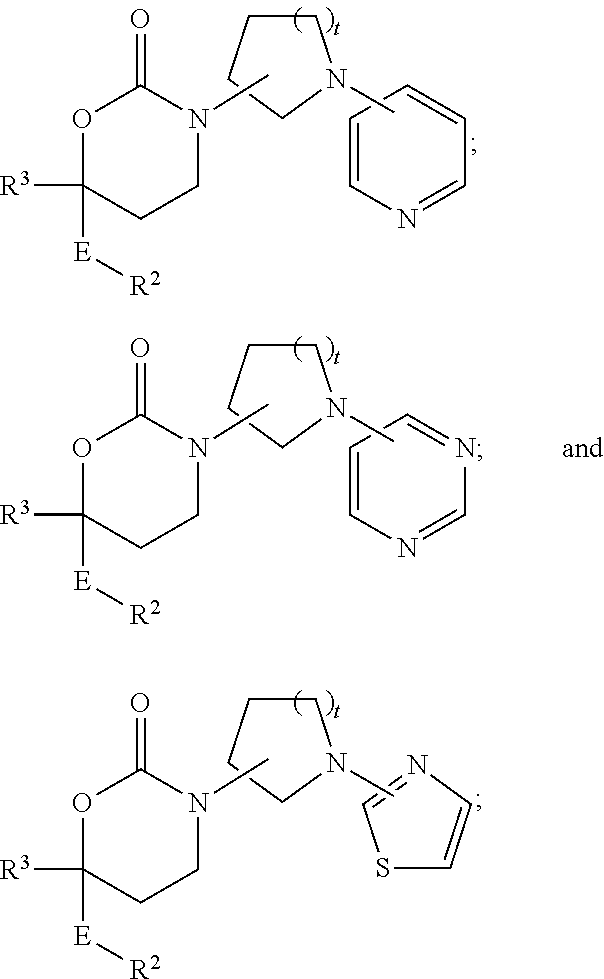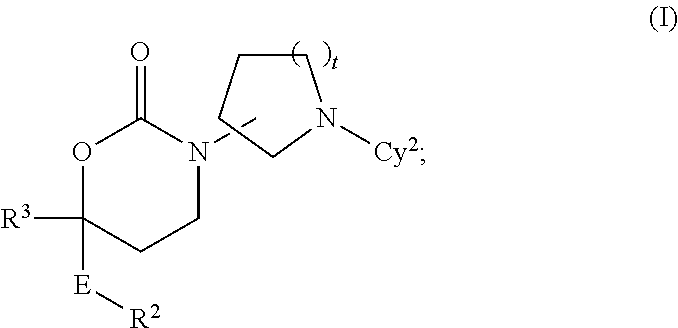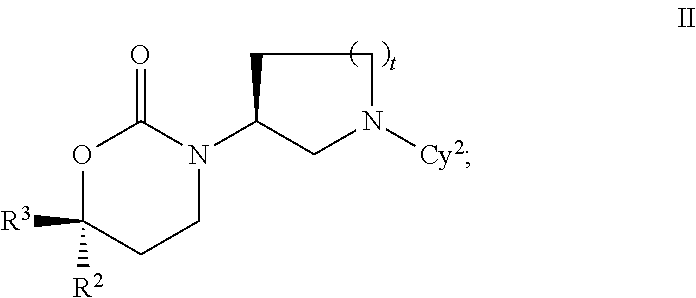Cyclic inhibitors of 11β-hydroxysteroid dehydrogenase 1
a technology of hydroxysteroid dehydrogenase and cyclic inhibitors, which is applied in the direction of antibacterial agents, immunological disorders, metabolism disorders, etc., can solve the problems of impaired glucose tolerance and/or type 2 diabetes, loss of partial visual field and eventually blindness, and adverse effects on skeletal tissues
- Summary
- Abstract
- Description
- Claims
- Application Information
AI Technical Summary
Benefits of technology
Problems solved by technology
Method used
Image
Examples
preparation 1
(S)-6-(2-hydroxy-2-methylpropyl)-6-phenyl-3-((S)-piperidin-3-yl)-1,3-oxazinan-2-one
[0190]
Step 1
[0191]To a well stirred mixture of 3-chloropropiophenone (10.0 g, 59.3 mmol), zinc powder (4.0 g, 1.03 equiv), satd aq NH4Cl solution (150 mL), THF (70 mL), a solution of the 3-bromo-2-methylprop-1-ene (16 g, 2 equiv) was added slowly. The reaction was exothermic mildly. After the addition, the mixture was heated to reflux for 1.5 h. After being cooled to rt, the mixture was diluted with EtOAc (200 mL), separated, washed with brine (35 mL), and dried over Na2SO4. After filtration and concentration, the residue was purified by chromatography on a 120 g silica gel column, eluted with a 0-10% methanol in CH2Cl2 gradient, to afford 1-chloro-5-methyl-3-phenylhex-5-en-3-ol (8.67 g product, 65% yield).
Step 2
[0192]A mixture of 1-chloro-5-methyl-3-phenylhex-5-en-3-ol (5.16g, 23mmol), (S)-tert-butyl 3-aminopiperidine-1-carboxylate (6.9 g, 1.5 equiv), KI (4.0 g, 1.05 equiv), K2CO3 (4.77 g, 1.5 equiv)...
preparation 2
(S)-6-(2-hydroxy-2-methylpropyl)-6-phenyl-3-((S)-pyrrolidin-3-yl)-1,3-oxazinan-2-one
[0198]
[0199]The title compound was prepared following procedures analogous to those described in Preparation 1 using (S)-tert-butyl 3-aminopyrrolidine-1-carboxylate in Step 2.
preparation 3
(S)-tert-butyl 3-((R)-6-(4-fluorophenyl)-6-(3-hydroxypropyl)-2-oxo-1,3-oxazinan-3-yl)piperidine-1-carboxylate
[0200]
Step 1. 1-chloro-3-(4-fluorophenyl)hex-5-en-3-ol
[0201]A 250-mL flask was charged with anhydrous CeCl3 (5.58 g, 22.6 mmol) and THF (40 mL). The mixture was vigorously stirred for 3.5 h at rt. The suspension was then cooled to −78 ° C. and a solution of allylmagnesium bromide (1.0 M in THF, 21 mL, 21.0 mmol) was added. After stirring for 2 h at −78 ° C., a solution of 3-chloro-1-(4-fluorophenyl)propan-1-one (2.522 g, 13.5 mmol) in THF (30 mL) was added via cannula. The reaction mixture was allowed to slowly warm to 8° C. while stirring overnight (18 h). The reaction was then quenched with satd aq NaHCO3, extracted with EtOAc, and dried over Na2SO4. After the solvents were evaporated, the residue was purified by chromatography on silica gel eluted with hexanes / EtOAc to afford of 1-chloro-3-(4-fluorophenyl)hex-5-en-3-ol (3.0049 g, 97%) as an oil. LC-MS Method 1 tR=1.79 min,...
PUM
 Login to View More
Login to View More Abstract
Description
Claims
Application Information
 Login to View More
Login to View More - R&D
- Intellectual Property
- Life Sciences
- Materials
- Tech Scout
- Unparalleled Data Quality
- Higher Quality Content
- 60% Fewer Hallucinations
Browse by: Latest US Patents, China's latest patents, Technical Efficacy Thesaurus, Application Domain, Technology Topic, Popular Technical Reports.
© 2025 PatSnap. All rights reserved.Legal|Privacy policy|Modern Slavery Act Transparency Statement|Sitemap|About US| Contact US: help@patsnap.com



